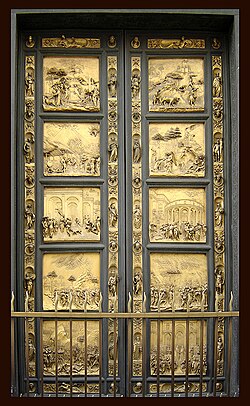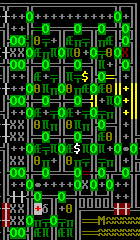- v50 information can now be added to pages in the main namespace. v0.47 information can still be found in the DF2014 namespace. See here for more details on the new versioning policy.
- Use this page to report any issues related to the migration.
DF2014:Door
"Door" in other Languages
|
| This article is about an older version of DF. |
| This feature has one or more outstanding bugs. |
Doors are pieces of furniture used mainly to control the movement of dwarves, pets, and liquids, and to define the exits of rooms. A door must be built next to a wall or other form of support*. Doors appear using different graphical tiles depending on their material.
- (* Note that a tile of tree roots is not adequate for this purpose.)
Materials
Doors can be made of stone (┼), metal (≡), glass (O), and wood (║). Artifact doors can also be made from gem (☼) and bone (║). A glass door is called a portal.
While stone, wood, and glass doors require only a single building material, metal doors require 3 bars to produce.
Usage
A door has three main settings:
- l Permit Passage/Forbid Passage: This locks or unlocks the door to (most) all creatures. The door cannot be passed unless it is permitted again or destroyed. Dwarves, wild and tame animals, and most invaders will all be unable to pass. However, thieves can pick the locks of locked doors, and building destroyers such as trolls will simply smash them down. Ghosts can also open locked doors, leaving them unlocked after passing through. After invaders take one of your doors, any member of your fort, including pets, can take it back for you.
- (Note: This does not "Forbid" the door itself in the usual sense. It only "forbids passage" - an unfortunate choice of words, perhaps, but hopefully not too confusing. Just think of lock/unlock and you'll be fine.)
- o Keep Tightly Closed/Make Pet-passable: This determines whether a door is left open to animals, allowing them to pass on their own. If set to "tightly closed", then dwarves, invaders and other sentient creatures will not be hindered, but animals will typically be unable to pass through. Note that animals may still be able to dart past the door for the short time it is open while a dwarf or other sentient creature goes through. (Or, say, a goblin that just so happened to be one of the 50 goblins that ambushed you was to open this door and let out those 500 ravenous Wardogs.]) Because of pathfinding issues, this setting has been known to cause game lag.Bug:797 Obviously, if a door is locked, neither animals nor others may pass.
- s Set as Internal/Set as External: A door set as "internal" will not block room expansion in the room-designating interface.
Doors can be connected to levers or pressure plates to open on command. A door that is connected to a lever cannot be opened and closed by a dwarf or animal any longer; it can only be opened and closed by pulling the lever.
Doors also halt the movement of liquids (water and magma) in the manner of floodgates, and can be used in the same ways if a passageway is narrow enough. The main differences between a door and a floodgate for fluid containment are:
- There is a delay in operating a floodgate with a lever, but no delay on a door.
- A door that's not linked to a lever can be opened or closed by a dwarf or an animal (unless locked and/or tightly closed); usually this is not what you want when there is an enormous amount of liquid on the other side of the door.
Animals only try to path through doors/hatches improperly when they are unlocked and tightly sealed (the latter specifically meaning "animals cannot open"), so a mechanism-controlled door/hatch is also identical to a floodgate from a pathfinding perspective.
Most wild animals do not have [CANOPENDOORS], so they can't open doors at all - presumably, Tame creatures are explicitly granted the ability to open pet-passable doors in your fortress.
Advanced Door Construction
The placement requirement for a door is that it must be positioned cardinally adjacent to a wall at the time of placement designation. That wall does not need to exist when the door is being constructed, nor does that wall need to exist for the door to continue to exist after it has been constructed. Thinking on this, one might discover that doors can be placed side by side in continuous strings, given a little extra effort.
You will normally begin the process by anchoring your first door placement designation against a constructed wall -- not a natural stone wall. Immediately afterwards, you can use the designations menu to nRemove constructions to clear a space for the next door. Once the space is clear, you can designate the construction of a second door, even before the first door has been constructed. Repeat the process for your third, fourth, fifth, etc. door until you are satisfied. You can continue the process indefinitely as long as you possess doors and constructed walls to anchor your placement designations. Note that natural stone walls do not work this way; digging out a natural wall will deconstruct any adjacent no-longer-supported doors.
You can also use this strategy to unhook doors from walls and leave them as free standing structures. Why you would want to do this is up to you, but some players may find this useful for baiting building destroyers away from their fortress.
Notes
- Any item on the same tile as a door will cause the door to be propped open, which makes it impossible to lock and will allow fluids in. Such items will also jam mechanically linked doors; in order for the door to be shut, the item must be cleared out and the lever or pressure plate must be triggered again.
- A door destroys any fluid on its tile when it closes.
- If any invaders do move past a door (locked or unlocked), they will "take control" of the door and you will be unable to change any q-settings. If you can successfully move a squad through that door, it will be retaken to your control, but the door will be returned in an unlocked state. A door set to be tightly-closed to animals will remain tightly closed when you retake it.
- Locked doors unlocked by ghosts, unlike those taken by invaders, can be immediately re-locked by the player using the q menu as soon as the ghost finishes passing through.
- Doors are a vital, if somewhat double-edged, component of Fortress defense. You could build your own shogunate castle by replacing your walls with doors, a tactic which will disorient your enemies with unlimited pathfinding options and provide your Hammerdwarves with excellent ambushing potential. Be warned, though: just as rice-paper walls have trouble keeping grown men at bay, you're going to have some fun with building destroyers. And thieves. Your haulers won't mind.
- Artifact doors are indestructible, and may be used to filter out building destroyers.
- Doors block trade depot access, regardless of their settings. And, no, you cannot build three-wide doors as a 'caravan garage door' - you're better off using a bridge or linked floodgates for that.
- All doors are watertight, but dwarves may allow small amounts through when they open a door to pass. If you need doors to a watery area such as a reservoir for an artificial waterfall or flood trap, you can limit the mess from escaping water by making each exit an "airlock": two doors enclosing a one- or two-tile room between the tank and the main hallway. The small amount of water that escapes will be contained in the room and evaporate. If the water level can potentially get too high to evaporate, channeling a drain and placing grates or floor bars is even more effective.
See also
| Furniture |
Altar • Animal trap • Armor stand • Bed • Box • Bucket • Cabinet • Cage • Coffin • Display case • Pedestal • Restraint • Seat • Slab • Statue • Table • Weapon rack |
|---|---|
| Tools | |
| Access | |
| Constructions | |
| Machine and trap parts |
Axle • Gear assembly • Lever • Millstone • Pressure plate • Roller • Screw pump • Support • Trap • Water wheel • Windmill |
| Other buildings | |
| Related articles | |

